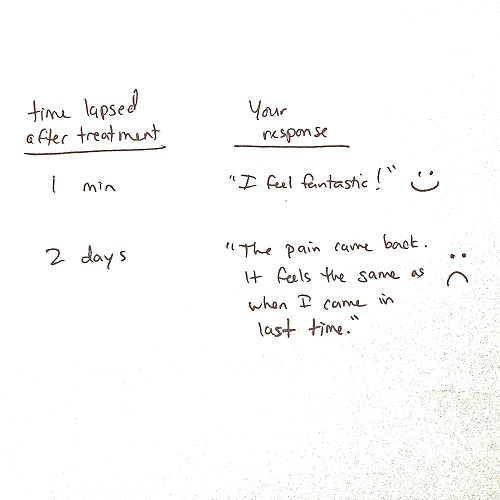
01 Nov Fake Pain Treatment and The Irrelevant Pain Relief Window (IPRW)
A new patient with low back pain walked into our office last week. Let’s call him Bob.
Bob was in a car accident in 1994, which gave him tingling down the back of both of his thighs immediately after the accident. The tingling was gone after a few months and Bob didn’t think anything more of it. (Anytime the word tingling is used, you can be very confident that nerves are compromised and not muscles, ligaments, tendons, or joints.)
Over the last few years, Bob’s low back pain has been starting earlier and earlier in his day with prolonged sitting, now occurring after 30 minutes of sitting instead of hours. To deal with this creeping low back pain, Bob has learned to take lots of sitting breaks, a good movement habit. He’ll stand and walk around for a few minutes every 30 minutes or so before sitting back down.
In addition to the intensifying low back pain, the tingling in his thighs has come back, along with a new symptom of tingling in the front of his thighs.
Bob has been getting his low back adjusted by two different chiropractors over the years, with smaller and smaller windows of relief. He now experiences relief, post-adjustment, for 48 hours until the pain comes roaring back.
Not only is Bob’s paradigm broken, but it’s allowing the problems causing his low back pain to become bigger and bigger.
Time for a paradigm shift Bob.
Anyone and Anything Can Give You Pain Relief
As a chronic pain resolution doctor, I’m often surprised in the ways that people find relief with pain treatment, even if they’ve suffered for months or years.
I’ve heard comments like:
A butter knife is a magical thing. I rubbed it on my thigh in the same way that you used the little metal credit card thingy. It worked!
I lay on the foam roller for an hour. It makes my back feel better.
The massage therapist spent 90 minutes working on me yesterday. He was basically putting his entire body weight on me the whole time. It hurt alot, but I sucked it up. And I feel great today!
Then, there are the people who don’t tell me the thoughts I know they’re thinking:
I take percocet every day. I can’t share that with you, the doctor, because I’m addicted and I don’t want you to tell me to stop taking them.
Below is a video (4 minutes long) of an enormous, almost unbelievable, range of improvement after 30 seconds or so of instrument treatment to a gentleman’s neck and face.
I’m not a gambling man. If I were, I’d put nearly everything I own on the gamble that if this same gentleman were tested 48 hours after this ” flexibility treatment”, his range of motion would be right back to where he was, pre-treatment.
In other words, the amazing flexibility treatment that worked amazingly in this person to make mammoth-sized range of motion improvements, was fake.
How about the butter knife, foam roller, massage therapist, and the percocet? Fake, fake, fake, fake!
Temporary Pain Relief or Flexibility Changes are Fake Pain Treatments
I was talking to a low back pain sufferer on Reddit about the life he thought he was going to live because of his low back pain until he healed it. He had this to say [the brackets are mine]:
It’s such an indescribable feeling waking up one morning without any back pain. The first month in pain I kept thinking it would pass, but after the first 6 months I was just consigned to a life of misery. And I could feel it making me a short-tempered asshole that no one wanted to be around.
To save those of you suffering from a life of misery, I speak. To give you that indescribable feeling of being pain-free again the way you were.
Bob wouldn’t have walked into our office if someone had educated him 20 years earlier after his car accident about what fake pain treatments look like.
If you feel good after a treatment, only to have the pain come back within 0-48 hours after the treatment, you received a fake pain treatment.
If your flexibility increases after a treatment, only to tighten up within 0-48 hours after the treatment, you received a fake mobility treatment.
If your pain increases over the long term with a doctor overseeing your load management, you’re not getting your problem addressed.
Temporary pain relief or flexibility changes are neurological reflexes. You’re not addressing the problem.
Neurological means nervous system related. Reflex means a pattern that is activated in a nerve, only to resort back to normal over time.
If you get pain relief from something, even if temporary, you’re probably wondering, “How is it fake?”
Treatment is fake when it looks like it worked, only to have the problem show its ugly head 48 hours later with the exact same qualities it had before you did the treatment. All you did was mess with your body’s feedback system.
To properly explain this phenomenon, let’s have the dysfunction conversation.
You’re Goal is Smaller and Smaller Blocks!
A problem in musculoskeletal terms is known as a dysfunction (which includes the areas of fitness, health, and pain).
In an ideal world, you’d be as healthy and fit as you want to be. If you were to draw your optimal health/fitness on a graph, it would look like this:
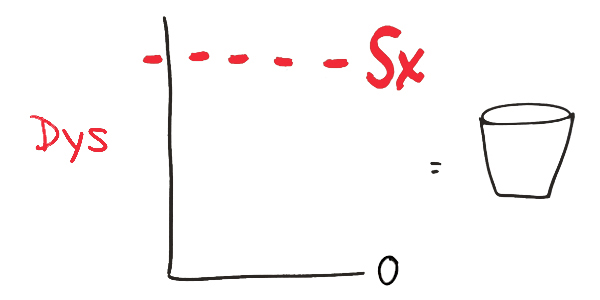
The Y-axis is how much dysfunction you have. “0” indicates you have no dysfunction blocks on your graph. No dysfunction blocks means your as healthy and fit as your genes allow you to be.
The size of the empty bucket is your capacity, or how much work your body can handle (imagine water filling your bucket as you do work) before experiencing any symptoms (Sx). Symptoms can be pain or just tightness.
Work (or load) can be exercise, how you hold your body throughout your day, or trauma. With gravity always pulling you down into the earth, anything you do in your 24 hours is working some body parts.
You can take the healthiest, fittest person in the world, let’s say Rich Froning in the CrossFit world. He is arguably the fittest man on earth. If Rich Froning got hit by a car, the work from the trauma would immediately fill his bucket up with water and overflow, causing pain. On the graph, this would be a dysfunction block that rises above the symptom threshold, the dotted line that says “Sx.”
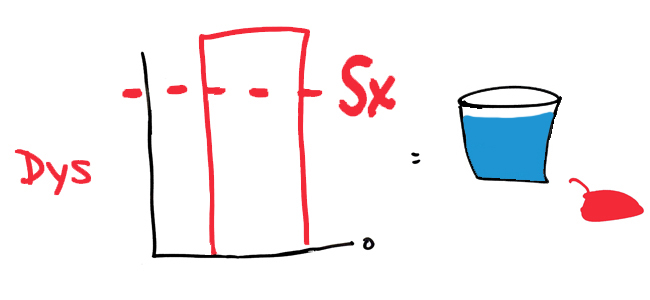
When you have frustrating pain that doesn’t go away, you normally have more than one block on your graph. The longer you’ve ignored your pain, the more blocks you have.
For ease of conversation, we’ll only use the one-block dysfunction graph here.
Real pain treatment makes your dysfunction block (or problem) smaller over time. This is the only goal that aims at longevity and permanence.
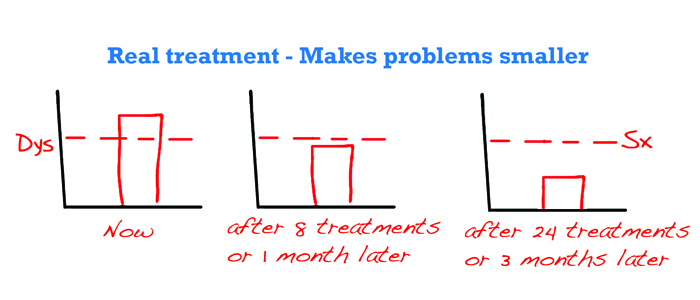
Fake pain treatment leaves your dysfunction block the same size. Worse, by being ignored, the block grows as you continue to feel the pain that is a sign that your overloaded tissue wants you to stop using it.
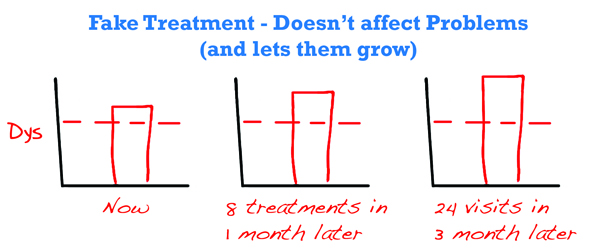
We know that Bob’s problem grew because he started experiencing it sooner after adjustments than in the past and sooner after prolonged sitting.
Instead of making your problem smaller, fake treatment temporarily increases the Sx Threshold Line by activating nerves. Those same nerves calm down in the 0-48 hour window.
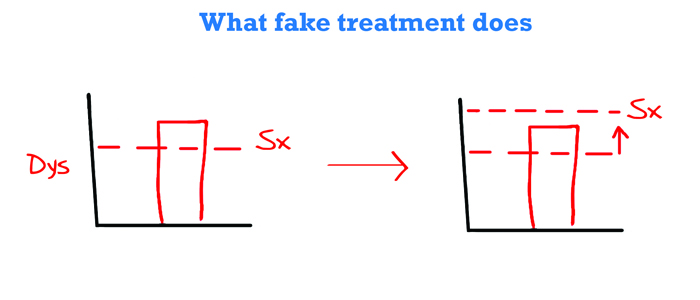
Notice in “What fake treatment does” above, the dysfunction block is no smaller than it was prior to treatment. It only moved the symptom threshold up for 0-48 hours.
Introducing the Irrelevant Pain Relief Window (IPRW)
The temporary decrease in your pain levels is called the Irrelevant Pain Relief Window (IPRW). This is the window of time between 0-48 hours after a treatment when you have pain relief or a flexibility increase, that always comes back to the baseline level of pain or tightness.
The pain relief is irrelevant because your problem hasn’t gotten any smaller. You’ve only decreased the pain temporarily. Because the problem is lingering underneath the surface, the treatment didn’t work for your goal of permanent improvement.
Let’s use a medical example.
Imagine an overweight, sedentary person who doesn’t exercise. After going to see his medical doctor who diagnoses him with high blood pressure, he’s prescribed blood-pressure lowering medications that get the blood pressure job done. Unfortunately, this gentleman is still overweight and at risk for many other diseases, not to fail to mention the side-effects of the medication that’s he now on for life.
Because the blood-pressure meds don’t address the problem itself (diet and exercise), the treatment is irrelevant. This man is still at risk of an earlier than desired death.
Addressing the excess weight through diet, exercise, and behavioral psychology to ensure success would be a relevant treatment addressing the cause of the high blood pressure.
Addressing your pain problem through techniques that permanently reduce your symptoms over time would be making the block smaller and addressing the cause of your pain.
Permanent decreases in your pain are caused by relevant treatments.
The temporary relief you get from chiropractic adjustments, foam rolling, acupuncture, medications, exercise, your butter knife, or any other intervention, is activating the IPRW.
And causing you to be on Bob’s path.
Real Pain Treatment Makes Permanent Pain Changes
Real treatment makes your dysfunction block smaller. By doing so, your pain is permanently improved.
The caveats to permanent resolution are the presence of the following dysfunction blocks on your pain graph:
- metabolic conditions (i.e. hypothyroid, diabetes, etc.)
- acute inflammation (i.e. redness, swelling, heat)
- structural problems (i.e. disc problems, degenerative changes, labrum tears, etc.)
- your inability to work less than your capacity over time – what a pain doctor would call load management.
These caveats are the minority to people making permanent improvements in their pain. The majority of people respond to adhesion removal quite well.
In order to get real treatment, you need to figure out what each dysfunction is on your graph, and provide a sweet-spot solution for that block.
If you are mindful enough to do this yourself, get to work yourself (diet, exercise, load management). If you know what your individual blocks are, see the appropriate provider for each block (For metabolic conditions, see functional medicine providers. For weakness problems, see strength coaches. For emotional issues, see a psychotherapist.)
If you don’t have any idea what your blocks are, find an Integrative Diagnosis (ID) provider.
Bob found an ID provider. It was me. I’ll let you know how Bob does in a few weeks.
 What has your experience been with the Irrevelant Pain Relief Window? Please share comments below.
What has your experience been with the Irrevelant Pain Relief Window? Please share comments below.

No Comments